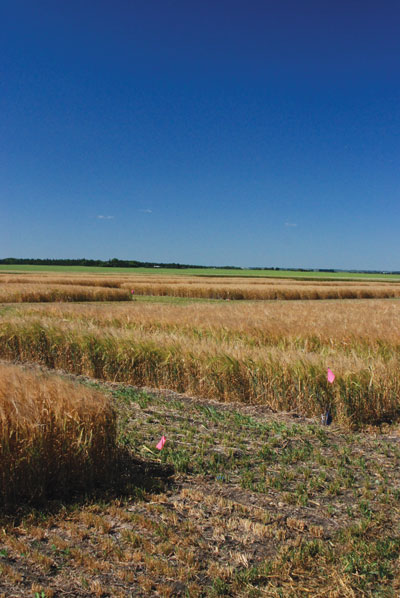
Features
Agronomy
Soybeans
Variable rate technology pays
Although not exactly run-of-the-mill, variable-rate technology is becoming more common at seeding. Farmers and researchers use data from yield and topographical maps or from satellite imagery to determine how to use certain inputs more profitably.
May 3, 2010 By Top Crop Manager
Although not exactly run-of-the-mill, variable-rate technology is becoming more common at seeding. Farmers and researchers use data from yield and topographical maps or from satellite imagery to determine how to use certain inputs more profitably.

|
|
| Ground-truthing has been a key part of precision farming research at Indian Head. (Photo by Bruce Barker) |
Dr. Guy Lafond of Agriculture and Agri-Food Canada, in collaboration with the Indian Head Agricultural Research Foundation, started experimenting with variable rate nitrogen in 1998. The Foundation purchased a half section of land to dedicate to precision farming experiments. “Our first kick at the can was to take a piece of land and see if we could identify unique production zones within the field,” says Lafond.
They used satellite imagery from three years in the late-1980s and early-90s and identified three distinct management zones in the field. They then verified the uniqueness of these zones using three years’ worth of yield maps. After ascertaining the uniqueness and stability of the management zones, they studied how each zone responded to nitrogen fertilizer. They found that for the most part, the response was very similar among the zones.
All that time and effort was not wasted. Using the results, they built a methodology that they were able to use in other fields to determine if the optimum N rate changed with management zones. They found similar results.
They then looked for a technology that could operate in real time. Lafond thinks that one approach is to use optical sensors mounted on a sprayer toolbar to measure crop characteristics. In this case it is crop biomass. The premise is that if crop growth can be measured, then the crop’s nutrient requirements can be estimated.
Using the optical sensor, they measure the yield potential of the crop early in the growing season and from there determine whether enough nutrients are present to realize that yield potential. They have developed algorithms for spring wheat and canola that the onboard computer uses to calculate N rates in real time while travelling across the field. “Optical sensors can be a tremendous management tool,” says Lafond. “We feel that it’s more quantitative and it takes into account spatial and temporal variability and works in real-time. You’re doing the application in the latter part of June and the beginning of July. The plant is telling you everything that it has experienced to date. You have the opportunity to make adjustments in the same growing season.”
Precision fungicide applications cut costs
Terry Aberhart is an Agri-Trend Agri-Coach near Langenburg, Saskatchewan. He and his father also farm 10,000 acres. He has been working with clients doing variable rate fertilizer and fungicide. “Ideally we’re looking to identify management zones in the field so we use multiple sources of data, such as satellite images or yield maps,” says Aberhart.
They also use a Veris machine to measure variations in soil. The Veris has six coulters that send out electrical currents to measure differences in resistance in the soil. This tells them whether the soil is lighter or heavier in texture. It also picks up salinity. Once completed, a grower has a map with zones that will not change from year to year. “On our farm, we don’t buy a blend of fertilizer anymore,” he says. “Most guys I’m working with are in the same position. Our N, P and K are in separate tanks. This means we can get a better deal on fertilizer. If guys decide to adjust target yield or crop rotation, it’s just a matter of changing on the go. Once you get set up with liquid N and have one tank for potassium and another for phosphorous, you can fine-tune to every single field.”
Aberhart also has been doing variable rate fungicide applications for sclerotinia control in canola. “The main reason variable rate fungicide works is that the disease pressure is almost directly correlated to the thickness of the canopy,” he says. “The heavier the canopy, the more risk of canola petals sticking to the plant and infecting it. Where the canopy is thinner, petals have more chance of falling to the ground where they can’t infect your crop.”
Ideally, Aberhart gets an aerial image taken of his canola fields 10 days before it is predicted he will need a fungicide application. They ground-truth what they see on the maps three to four days before spraying to ensure that the image is not affected by weed patches like wild oats or insect damage, application errors or anything else that could affect the growth of the crop. This way they make sure they are applying the right amount of product to the right place. “In one field we did in 2009 we ended up spraying 55 percent of the fungicide that we would have used,” he says.
It was a 135-acre field and a little more than half was sprayed. The boom was shut off in areas where the crop was thin. “Instead of spending $20 per acre across the field, we spent $13,” he says. “We’re saving $2 to $3 per acre on average on the cost of fungicide, even after factoring in the cost of the image and walking the fields.”
“Another big thing is the time factor,” he says. “Instead of spraying whole fields and areas that don’t need it we just cover the spots that need it the most. It matters with large farms trying to get across a lot of acres.”
|